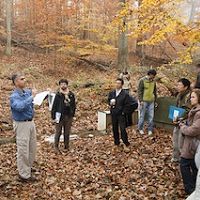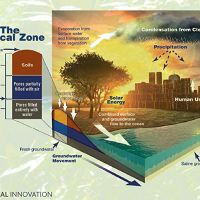Louis A. Kaplan

INVESTIGATOR
PI, CRB Stream Lead
.(JavaScript must be enabled to view this email address), 610.268.2153 x228
Christina Senior Research Scientist; Principal Investigator of Biogeochemistry group; Stroud Water Research Center
Stroud Water Res. Ctr. - Stroud Water Research Center
Kaplan's Stroud Water Res. Ctr. page
Ph.D., Biology (Limnology), University of Pennsylvania, 1980
Organic matter biogeochemistry, aquatic microbial ecology and nutrient cycling, especially the characterization and quantification of biodegradable dissolved organic carbon and the structure of microbial communities in stream ecosystems.
Phone/Address
610.268.2153 x228Stroud Water Research Center, 970 Spencer Road, Avondale, PA 19311
Links
-
CZO Publications
Papers/Books
2016
Variation of organic matter quantity and quality in streams at Critical Zone Observatory watersheds. Miller, Matthew P., Boyer, Elizabeth W., McKnight, Diane M., Brown, Michael G., Gabor, Rachel S., Hunsaker, Carolyn T., Iavorivska, Lidiia, Inamdar, Shreeram, Johnson, Dale W., Kaplan, Louis A., Lin, Henry, McDowell, William H., Perdrial, Julia N. (2016): Water Resources Research, 52 (10): 8202–8216 Cross-CZO
2014
The delivery of dissolved organic carbon from a forest hillslope to a headwater stream. Mei, Y. Hornberger, G., Kaplan, L. A., Newbold, J. D., & Aufdenkampe, A. K. (2014): Water Resources Research 50 (7): 5774–5796
2014
Hydrologic dynamics and geochemical responses within a floodplain aquifer and hyporheic zone during Hurricane Sandy. Sawyer, A.H., L.A. Kaplan, O. Lazareva, and H.A. Michael (2014): Water Resources Research, 50 (6): 4877–4892
2014
A coupled geochemical and biogeochemical approach to characterize the bioreactivity of dissolved organic matter from a headwater stream. Sleighter, R. L., R. M. Cory, L. A. Kaplan, H. A. N. Abdulla, and P. G. Hatcher (2014): Journal of Geophysical Research: Biogeochemistry 119 (8):1520-1537
2013
Biological lability of dissolved organic carbon in stream water and contributing terrestrial sources. McLaughlin, C., and L. A. Kaplan (2013): Freshwater Science 32(4):1219-1230
2013
Measuring heterotrophic respiration rates of suspended particulate organic carbon from stream ecosystems. Richardson, D. C., J. D. Newbold, A. K. Aufdenkampe, P. G. Taylor, and L. A. Kaplan (2013): Limnology and Oceanography-Methods 11:247-261
2013
A variable source area for groundwater evapotranspiration: impacts on modeling stream flow. Tsang, Y.-P., Hornberger, G., Kaplan, L. A., Newbold, J. D. and Aufdenkampe, A. K. (2013): Hydrol. Process.
2012
Biological lability of streamwater fluorescent dissolved organic matter. Cory, Rose M. and L. A. Kaplan (2012): Limnology and Oceanography, 57(5):1347–1360
2012
Estimation of dissolved organic carbon contribution from hillslope soils to a headwater stream. Mei, Y., G. M. Hornberger, L. A. Kaplan, J. D. Newbold, and A. K. Aufdenkampe (2012): Water Resour. Res. 48(9)
2009
The boundless carbon cycle. Battin, T. J., S. Luyssaert, L. A. Kaplan, A. K. Aufdenkampe, A. Richter, and L. J. Tranvik (2009): Nature Geoscience 2:598-600
2009
Temporal dynamics of seston: A recurring nighttime peak and seasonal shifts in composition in a stream ecosystem. Richardson, D. C., L. A. Kaplan, J. D. Newbold, and A. K. Aufdenkampe (2009): Limnology and Oceanography 54:344-354
2008
Biophysical controls on organic carbon fluxes in fluvial networks. Battin, T. J., L. A. Kaplan, S. Findlay, C. S. Hopkinson, E. Marti, A. I. Packman, J. D. Newbold, and F. Sabater (2008): Nature Geoscience 1:95-100
2008
Biome-level biogeography of streambed microbiota. Findlay, R. H., C. Yeates, M. A. J. Hullar, D. A. Stahl, and L. A. Kaplan (2008): Applied and Environmental Microbiology 74:3014-3021
2008
Untangling the complex issue of dissolved organic carbon uptake: a stable isotope approach. Kaplan, L. A., T. N. Wiegner, J. D. Newbold, P. H. Ostrom, and H. Gandhi (2008): Freshwater Biology 53:855-864
2006
Recurring seasonal dynamics of microbial communities in stream habitats. Hullar, M. A. J., L. A. Kaplan, and D. A. Stahl (2006): Applied and Environmental Microbiology 72:713-722
2006
Biodegradable dissolved organic matter in a temperate and a tropical stream determined from ultra-high resolution mass spectrometry. Kim, S., L. A. Kaplan, and P. G. Hatcher (2006): Limnology and Oceanography, 51:1054-1063
2005
Contribution of dissolved organic carbon to stream metabolism estimated with 13C-enriched tree tissue leachate. Wiegner, T. N., L. A. Kaplan, J. D. Newbold, and P. H. Ostrom (2005): Journal North American Benthological Society 24:48-67
2004
Riparian Deforestation, Stream Narrowing, and Loss of Stream Ecosystem Services. Sweeney, B. W., T. L. Bott, J. K. Jackson, L. A. Kaplan, J. D. Newbold, L.J. Standley, W. C. Hession, and R. J. Horwitz (2004): Proceedings of the National Academy of Sciences 101:14132-14137
2003
Contributions of microbial biofilms to ecosystem processes in stream mesocosms. Battin, T. J., L. A. Kaplan, J. D. Newbold, and C. E. Hansen (2003): Nature 426:439-442
2003
A mixing model analysis of stream solute dynamics and the contribution of a hyporheic zone to ecosystem function. Battin, T. J., L. A. Kaplan, J. D. Newbold, and S. P. Hendricks (2003): Freshwater Biology:48:995-1014
2003
Effects of current velocity on the nascent architecture of stream microbial biofilms. Battin, T. J., L. A. Kaplan, J. D. Newbold, X. Cheng, and C. Hansen (2003): Applied and Environmental Microbiology. 63:5443-5452
2003
The role of monomers in stream ecosystem metabolism. Kaplan, L. A., and J. D. Newbold (2003): Aquatic Ecosystems: Interactivity of Dissolved Organic Matter, pp. 97-119. S. E. G. Findlay and R. L. Sinsabaugh (eds.). Academic Press.
2003
Where rivers are born: The scientific imperative for defending small streams and wetlands. Meyer, J. L., L. A. Kaplan, J. D. Newbold, D. L. Strayer, C. J. Woltemade, J. B. Zedler, R. Beilfuss, Q. Carpenter, R. Semlitsch, M.C. Watzin, and P. H. Zedler (2003): Sierra Club and American Rivers
2000
Surface and subsurface dissolved organic carbon. Kaplan, L. A., and J. D. Newbold (2000): Streams and Ground Waters, J. B. Jones and P. J. Mulholland (eds.), pp. 237-258. Academic Press.
1997
Organic matter dynamics in White Clay Creek, Pennsylvania, USA. Newbold, J. D., T. L. Bott, L. A. Kaplan, B. W. Sweeney, and R. L. Vannote (1997): Pages 46 - 50 in J. R. Webster and J. L. Meyers (editors). Stream organic matter budgets. Journal of the North American Benthological Society 16:3-161
1995
Measurement of streamwater biodegradable dissolved organic carbon with a plug-flow bioreactor. Kaplan, L. A. and J. D. Newbold (1995): Water Research 29:2696-2706
1993
Sources and biogeochemistry of terrestrial dissolved organic carbon entering streams. Kaplan, L. A., and J. D. Newbold (1993): pp. 139 - 165 in T. E. Ford, ed. Aquatic microbiology: an ecological approach. Blackwell Scientific
Papers and books that explicitly acknowledge a CZO grant are highlighted in PALE ORANGE.
Other CZO Publications
2012
The Christina River Basin Critical Zone Observatory (CRB-CZO): Quantifying carbon sequestration by integrating spatial and temporal carbon and mineral fluxes. J. Kan, D. Karwan, O. Lazareva, C. Rosier, A. Aufdenkampe, D. L. Sparks, L. A. Kaplan, J. Pizzuto, K. Yoo (2012): The 2nd International Conference of Geobiology-Critical Zone Observatories for sustainable soil development and beyond. Sept 4-8, 2012, Wuhan, China.
2012
2012 CRB-CZO Annual Report to National Science Foundation. Sparks, D., Aufdenkampe, A., Kaplan, L., Pizzuto, J., and Yoo, K. (2012): NSF Award #0724971
2011
A wireless environmental sensor network based on open-source electronics for the Christina River Basin CZO. Hicks, S., Aufdenkampe, A., Lazareva, O., Montgomery, D., Kaplan, L., Newbold, D., Levia, D., Sparks, D.L. (2011): CZO National Meeting, Tucson, Arizona
2011
A 13C DOC tracer approach to estimate the contribution of semi- labile dissolved organic carbon to stream ecosystem metabolism. Kaplan, L.A., J. D. Newbold and A. K. Aufdenkampe. (2011): Goldschmidt 2011 conference, Prague, Czech Republic, August 14-19. p. 1147
2011
2011 CRB-CZO Annual Report to National Science Foundation. Sparks, D., Aufdenkampe, A., Kaplan, L., Pizzuto, J., and Yoo, K. (2011): NSF Award #0724971
2011
Christina River Basin Critical Zone Observatory (CRB-CZO): Wireless environmental sensor network. Sparks, D.L., Aufdenkampe, A., Lazareva, O., Hicks, S., Montgomery, D., Arscott, D., Kaplan, L., Newbold, D., Levia, D. (2011): University of Delaware on the Hill. Capitol Hill, Washington, DC, March.
2011
Christina River Basin Critical Zone Observatory (CRB-CZO): Wireless environmental sensor network. Sparks, D.L., Aufdenkampe, A., Lazareva, O., Hicks, S., Montgomery, D., Arscott, D., Kaplan, L., Newbold, D., Levia, D. (2011): EPSCoR Annual Meeting, Dover, Delaware, April.
2010
Christina River Basin CZO: Spatial and temporal integration of carbon and mineral fluxes: a whole watershed approach to quantifying anthropogenic modification of critical zone carbon sequestration. Aufdenkampe, A.K., D.L. Sparks, L.A. Kaplan, J.E. Pizzuto, K. Yoo (2010): Invited Talk at the quarterly meeting of the Christina River Basin Task Force, Dec. 3, Newark, DE
2010
Advances in Understanding Watershed Processes with Real-time in-Situ Sensor Networks for Surface and Ground Water Properties. Aufdenkampe, A.K., J.D. Newbold, D. Arscott, L.A. Kaplan, M.S. Johnson (2010): Invited Talk at the Pennsylvania Water Symposium, May 6, State College, PA
2010
Spatial And Temporal Integration Of Carbon And Mineral Fluxes: A Whole Watershed Approach To Quantifying Anthropogenic Modification Of Critical Zone Carbon Sequestration. Aufdenkampe, A.K., Sparks, D.L., Yoo, K., Kaplan, L. A., and Pizzuto, J.E. (2010): 3rd Annual National CZO PI meeting, Boulder, CO, September 13-15.
2010
The Delivery Of Dissolved Organic Carbon From Forest Soils To A Head Water Stream . Mei, V., G.M. Hornberger, L. Kaplan, J. D. Newbold, A. K. Aufdenkampe. (2010): Abstract H53B-1031. AGU Fall Meeting, San Francisco, CA, December 13-17
2010
2010 CRB-CZO Annual Report to National Science Foundation. Sparks, D., Aufdenkampe, A., Kaplan, L., Pizzuto, J., and Yoo, K. (2010): NSF Award #0724971
2008
Protecting Headwaters: The scientific basis for safeguarding stream and river ecosystems. Kaplan, L. A., T. L. Bott, J. K. Jackson, J. D. Newbold, and B. W. Sweeney (2008): Stroud Water Research Center
-
Models
PIHM_DOC
Penn State Integrated Hydrological Model for Dissolved Organic Carbon
PIHM is a physically based, fully distributed hydrological model
IDOCM_1D
Integrated one dimensional physically-based dissolved organic carbon model
A one-dimensional transport model for heat, and biodegradeable and refractory dissolved organic carbon in soils
FEMDOC_2D
Two-dimensional finite element model for hillslope DOC
Physically based model of water, heat, refractory DOC and biodegradable DOC transport on a 2D (vertical cross section) hillslope
-
News

CZO REUs and RETs present research at 2014 CUAHSI Biennial Meeting
26 Aug 2014 - The Critical Zone Observatory Research Experience for Undergraduates and Research Experience for Teachers program participants traveled to...

International Innovation Publishes August Edition with Special Focus on US Critical Zone Program
30 Aug 2012 - The European magazine, International Innovation Environment, published bi-annually, focused the August issue on "How science must lead the way to a...

A critical workshop - Landmark international workshop for critical zone scientists held at UD
18 Jan 2012 - International collaboration in critical zone science took a giant step forward in November when about 80 researchers from the U.S., Europe, China...

Critical research: Understanding complex interactions within Earth’s critical zone
15 Dec 2011 - Donald Sparks, Anthony Aufdenkampe, and Lou Kaplan reveal their progress in understanding the complex interactions within the Earth's critical zone

Christina River Basin Critical Zone Observatory Featured in NSF Video
22 Jun 2010 - The National Science Foundation’s Science360 daily news service website has posted a video that includes a segment on the Christina River...

Team to study human effect on watershed
19 Oct 2009 - The narrow creek that runs behind the Stroud Water Research Center has witnessed plenty of changes over the centuries. Hundreds of years ago,...

New Critical Zone Observatory seeks to answer climate change questions
28 Sep 2009 - The University of Delaware, in collaboration with Stroud Water Research Center in Avondale, Pa., has received a $4.3 million grant from the National...
-
Events
Explore Further



